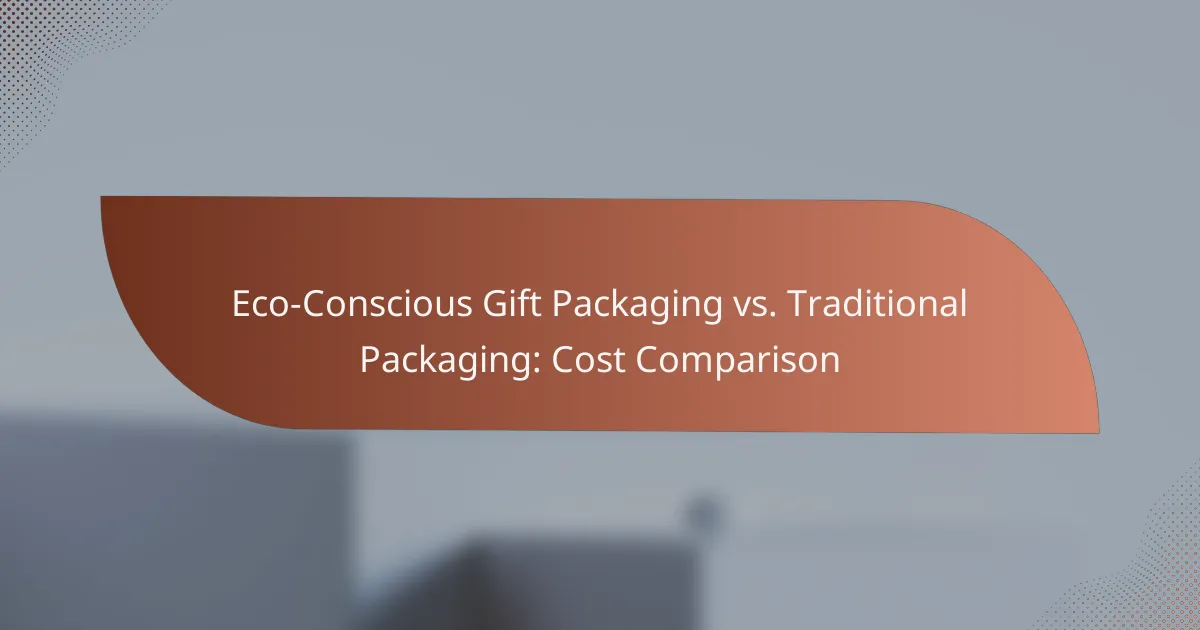As businesses increasingly prioritize sustainability, the cost comparison between eco-conscious gift packaging and traditional methods becomes crucial. While eco-friendly options often come with a higher initial price tag, they can lead to long-term savings through reduced waste and increased brand loyalty. By investing in sustainable materials, companies not only appeal to environmentally conscious consumers but also potentially lower operational costs over time.
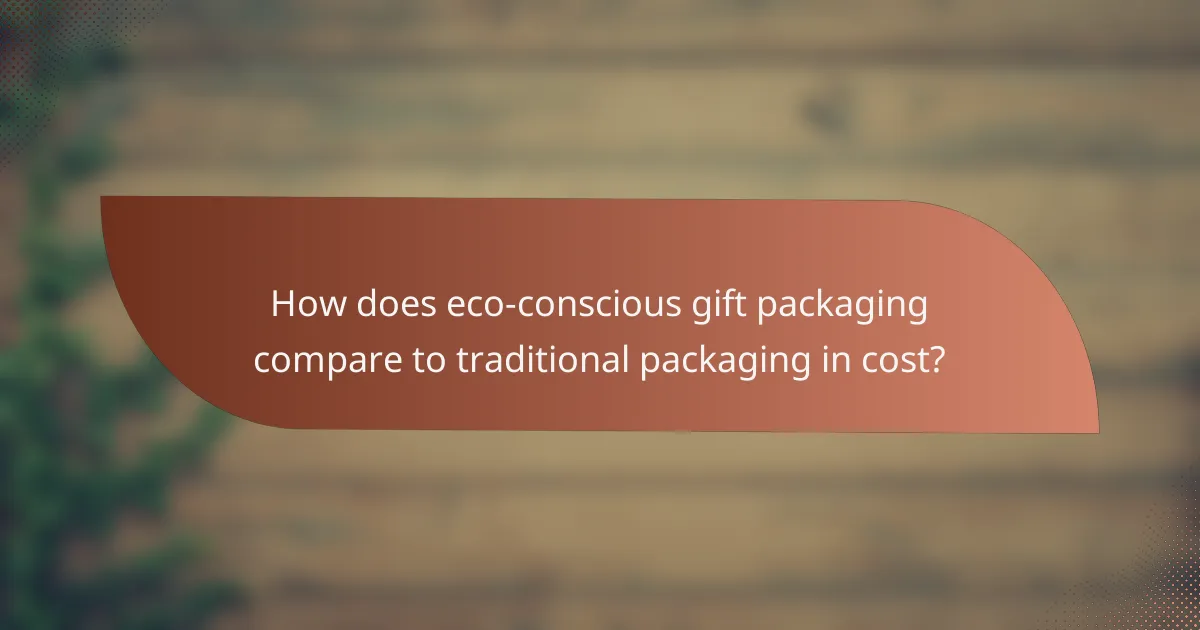
How does eco-conscious gift packaging compare to traditional packaging in cost?
Eco-conscious gift packaging typically incurs a higher upfront cost compared to traditional packaging methods. However, this initial expense can be offset by long-term benefits such as brand loyalty and reduced environmental impact.
Eco-conscious packaging often has a higher upfront cost
Eco-friendly packaging materials, such as biodegradable plastics, recycled paper, or plant-based options, usually come with a higher price tag than conventional materials. For example, while traditional plastic bags may cost a few cents each, biodegradable alternatives can be several times more expensive.
Additionally, sourcing sustainable materials may involve higher transportation costs and limited availability, particularly in regions where eco-friendly options are not yet mainstream. Businesses should consider these factors when budgeting for packaging.
Traditional packaging may have lower initial expenses
Traditional packaging solutions, such as plastic and Styrofoam, often have lower initial costs due to mass production and widespread availability. For instance, a standard cardboard box might cost less than a similar box made from recycled materials.
However, while traditional packaging may save money upfront, it can lead to higher long-term costs associated with waste disposal and environmental regulations. Companies should weigh these factors against the immediate savings to make informed decisions about their packaging strategy.
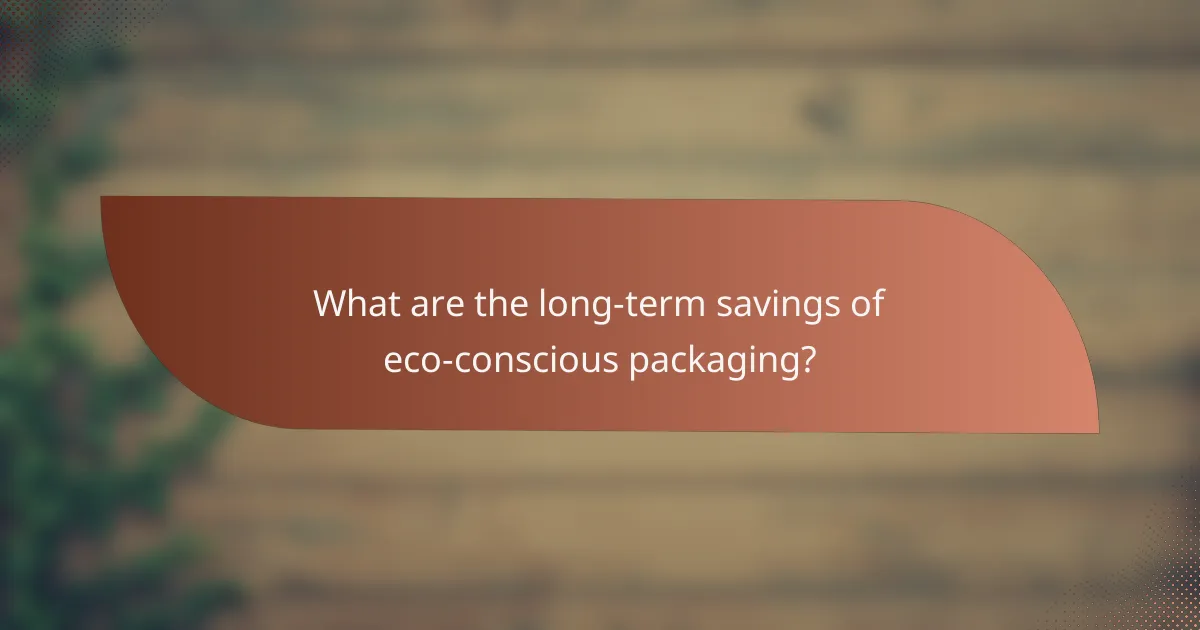
What are the long-term savings of eco-conscious packaging?
Eco-conscious packaging can lead to significant long-term savings by reducing material costs and minimizing waste disposal fees. By investing in sustainable materials and practices, businesses can lower their operational expenses while also appealing to environmentally aware consumers.
Reduced waste disposal costs
Using eco-conscious packaging often results in lower waste disposal costs. Many municipalities charge fees based on the volume of waste generated, so reducing packaging waste can lead to substantial savings. For example, businesses that switch to biodegradable or recyclable materials may find that their waste management expenses decrease by a noticeable percentage.
Additionally, companies can enhance their sustainability image, potentially attracting more customers who prioritize eco-friendly practices. This shift can create a positive feedback loop, where reduced costs and increased sales reinforce each other.
Potential tax incentives for sustainable practices
Many governments offer tax incentives for businesses that adopt sustainable practices, including eco-conscious packaging. These incentives can take various forms, such as tax credits or deductions for using environmentally friendly materials. Depending on the region, these benefits can significantly offset the initial investment in sustainable packaging solutions.
For instance, in the European Union, businesses may qualify for grants or reduced tax rates if they implement eco-friendly practices. Companies should research local regulations and consult with tax professionals to maximize potential savings from these incentives.
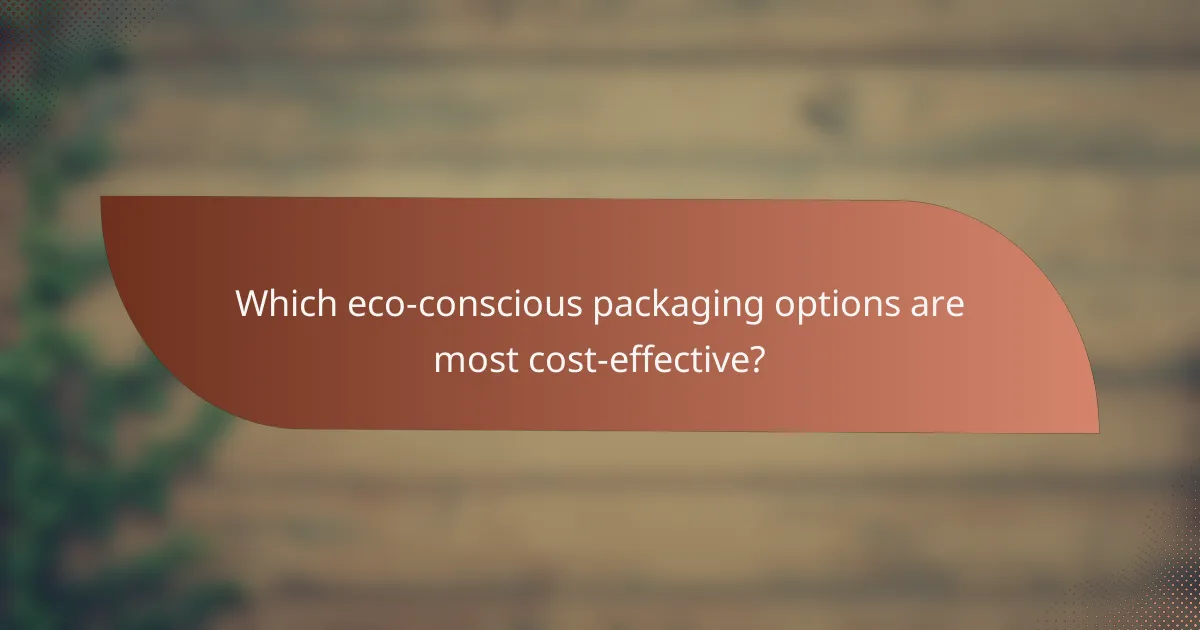
Which eco-conscious packaging options are most cost-effective?
Eco-conscious packaging options can be cost-effective, particularly when considering long-term savings and environmental benefits. Both recycled paper and biodegradable materials offer viable alternatives to traditional packaging, often at competitive prices.
Recycled paper and cardboard
Recycled paper and cardboard are among the most affordable eco-friendly packaging options available. They typically cost about the same as standard paper products, making them an easy switch for businesses looking to reduce their environmental impact without incurring significant expenses.
When selecting recycled materials, consider the percentage of post-consumer content, as higher percentages can enhance sustainability. Many suppliers offer bulk discounts, which can further lower costs, especially for businesses that require large quantities.
Biodegradable materials
Biodegradable materials, such as plant-based plastics and compostable films, can vary in price but are increasingly competitive with traditional options. While initial costs may be slightly higher, the growing demand is driving prices down, making them more accessible for businesses.
It’s essential to evaluate the end-of-life options for biodegradable packaging, as some require specific composting conditions to break down effectively. Always check local regulations regarding disposal to ensure compliance and maximize environmental benefits.
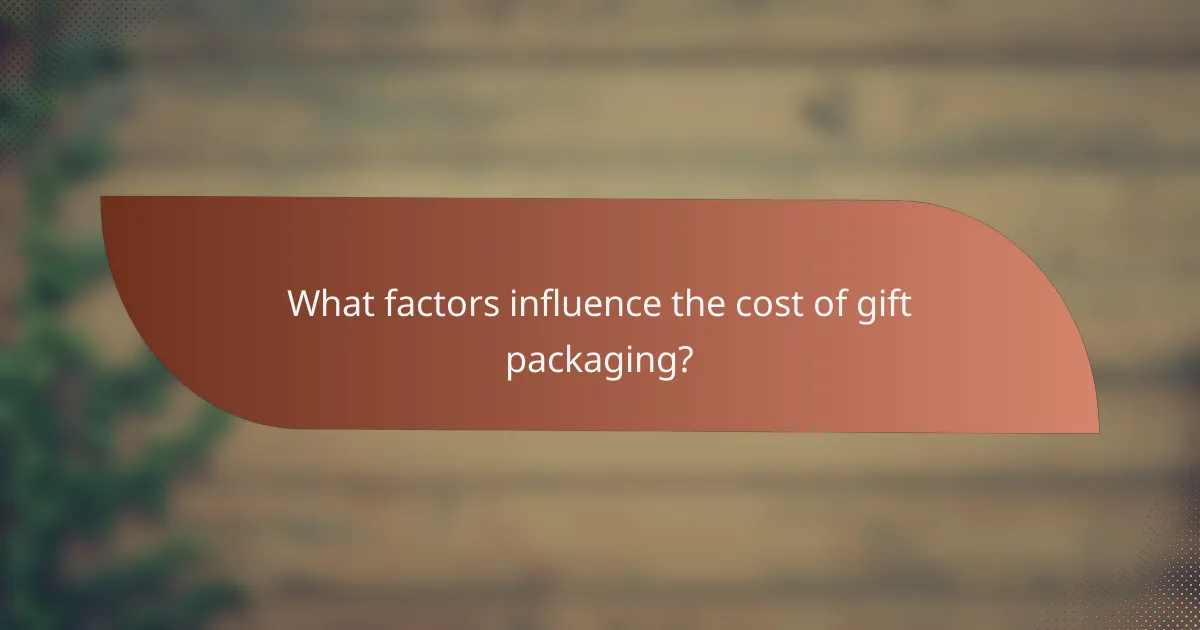
What factors influence the cost of gift packaging?
The cost of gift packaging is influenced by several factors, including the materials used, production methods, and shipping expenses. Understanding these elements can help consumers make informed choices between eco-conscious and traditional packaging options.
Material sourcing and production methods
Material sourcing plays a crucial role in determining the cost of gift packaging. Eco-friendly materials, such as recycled paper or biodegradable plastics, often have higher initial costs due to sustainable sourcing practices. Traditional packaging materials, like plastic and non-recycled paper, may be cheaper but can have hidden environmental costs.
Production methods also impact pricing. Eco-conscious packaging often involves more labor-intensive processes, which can increase costs. In contrast, mass-produced traditional packaging can benefit from economies of scale, resulting in lower prices for consumers.
Shipping and handling expenses
Shipping and handling expenses can vary significantly between eco-conscious and traditional packaging. Eco-friendly packaging may be lighter or more compact, potentially reducing shipping costs. However, if the materials are sourced from far away, transportation expenses could offset these savings.
Additionally, the durability of packaging affects handling costs. Traditional packaging may be more robust, leading to fewer damages during transit, while eco-friendly options might require careful handling, increasing the likelihood of returns and additional shipping fees.
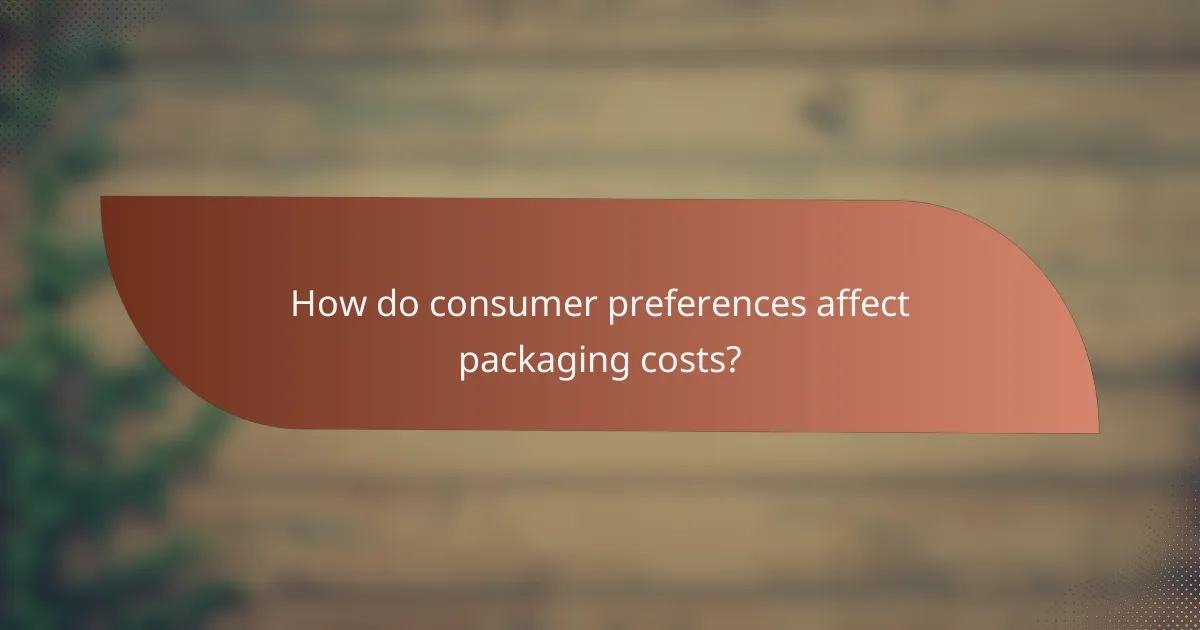
How do consumer preferences affect packaging costs?
Consumer preferences significantly influence packaging costs by driving demand for more sustainable options. As shoppers increasingly prioritize eco-friendly products, companies must adapt their packaging strategies, which can lead to varying cost implications.
Increased demand for sustainable options
The rise in consumer interest in sustainable packaging has prompted many businesses to shift away from traditional materials. This transition often involves higher initial costs due to sourcing eco-friendly materials like recycled paper or biodegradable plastics. However, these investments can lead to long-term savings through improved brand loyalty and reduced waste disposal fees.
Companies may also face increased production costs when implementing sustainable practices, such as using smaller batch sizes or more complex manufacturing processes. It’s essential for businesses to weigh these costs against potential benefits, including attracting environmentally conscious consumers.
Willingness to pay more for eco-friendly products
Many consumers are willing to pay a premium for eco-friendly products, which can offset the higher costs associated with sustainable packaging. Studies suggest that a significant portion of shoppers, particularly millennials and Gen Z, prefer brands that demonstrate environmental responsibility, often leading to increased sales for those companies.
To capitalize on this trend, businesses should clearly communicate their commitment to sustainability through marketing and product labeling. This transparency can enhance consumer trust and justify any additional costs, ultimately making eco-conscious packaging a viable option for many brands.
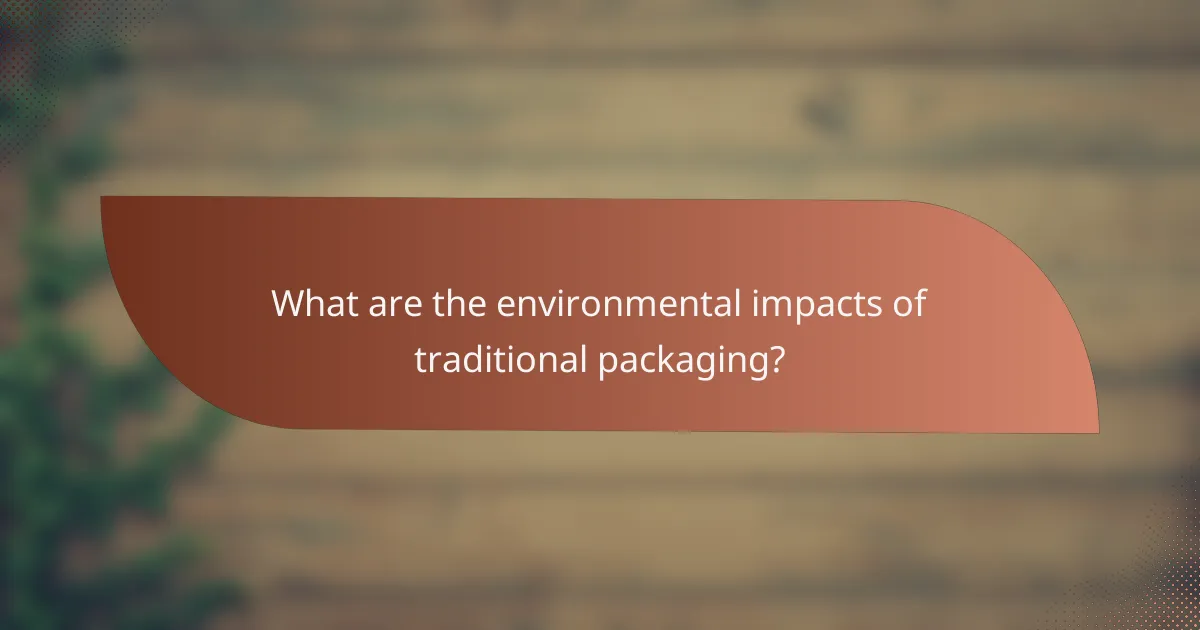
What are the environmental impacts of traditional packaging?
Traditional packaging significantly contributes to environmental degradation through high carbon emissions and excessive waste. Its reliance on non-biodegradable materials exacerbates pollution and resource depletion.
Higher carbon footprint
Traditional packaging often involves materials like plastic and Styrofoam, which require substantial energy for production and transportation. This process emits greenhouse gases, contributing to climate change. For instance, the carbon footprint of producing plastic can be several times higher than that of biodegradable alternatives.
When considering packaging options, it’s essential to evaluate the entire lifecycle, from raw material extraction to disposal. Opting for materials with lower energy requirements can help reduce overall emissions.
Increased landfill waste
Traditional packaging generates significant landfill waste, as many materials do not decompose for hundreds of years. This accumulation not only occupies valuable land but also leads to leachate and methane emissions, which are harmful to the environment.
To mitigate landfill contributions, businesses and consumers should consider using recyclable or compostable packaging. Implementing a take-back program can also help ensure that packaging is properly disposed of or reused, reducing the burden on landfills.
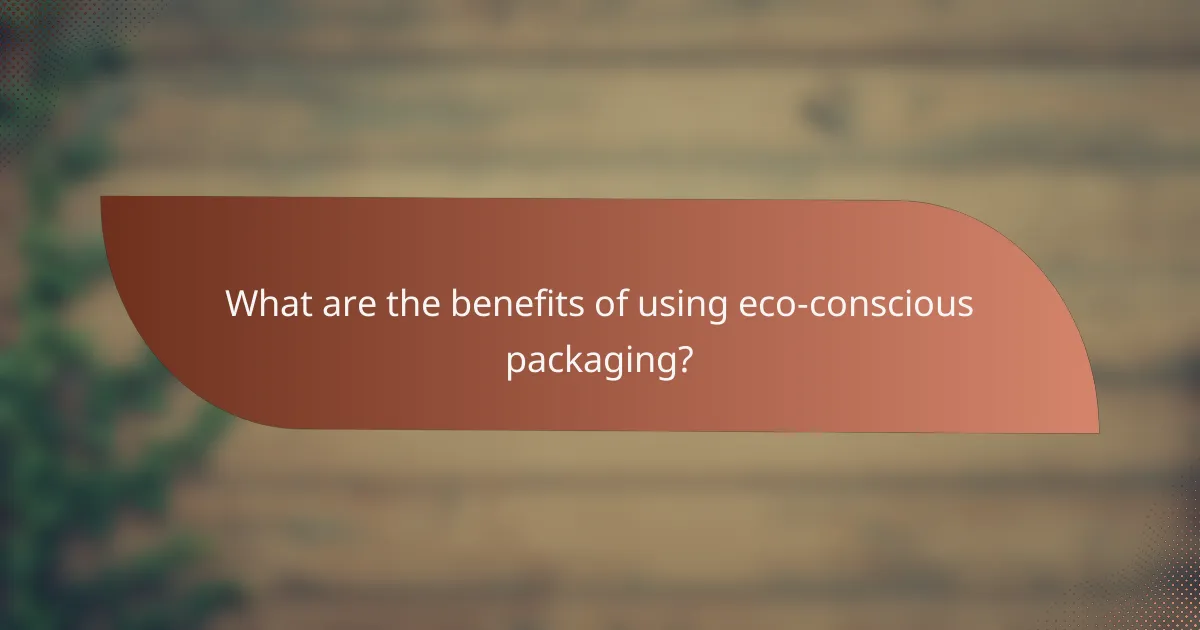
What are the benefits of using eco-conscious packaging?
Eco-conscious packaging offers several advantages, including reduced environmental impact and enhanced brand reputation. By utilizing sustainable materials, businesses can appeal to environmentally aware consumers and contribute to a healthier planet.
Environmental Impact
Eco-conscious packaging significantly lowers waste and pollution compared to traditional options. Materials such as biodegradable plastics, recycled paper, and plant-based substances decompose more easily, reducing landfill contributions. This shift not only conserves resources but also minimizes carbon footprints.
Cost Considerations
While eco-conscious packaging may have higher upfront costs, it can lead to long-term savings. Many sustainable materials are becoming more affordable as demand increases. Additionally, companies can save on disposal costs and potential fines associated with non-compliance to environmental regulations.
Consumer Preferences
Today’s consumers are increasingly prioritizing sustainability when making purchasing decisions. Studies indicate that a significant portion of shoppers are willing to pay more for products with eco-friendly packaging. This trend can enhance customer loyalty and attract new clientele who value environmental responsibility.
Brand Image and Marketing
Using eco-conscious packaging can improve a brand’s image and marketability. Companies that adopt sustainable practices often experience positive media coverage and customer engagement. Highlighting eco-friendly initiatives in marketing strategies can differentiate a brand in a competitive marketplace.
